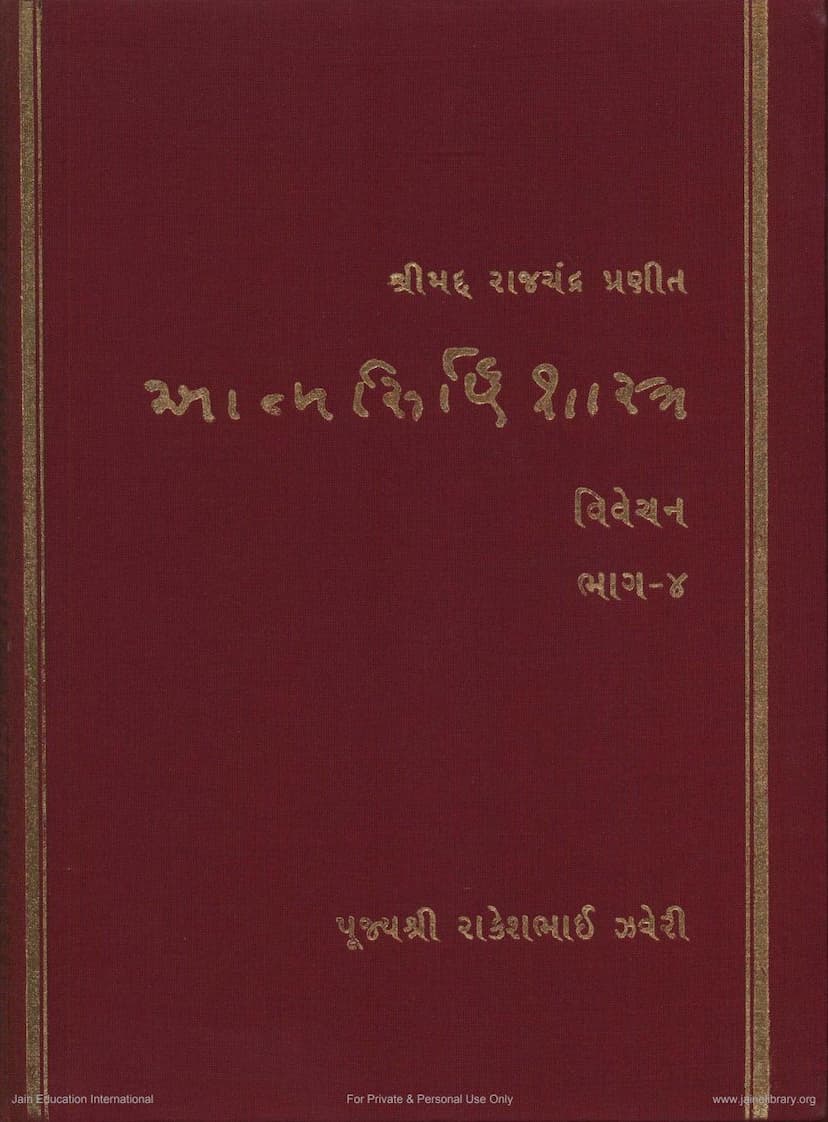Atma Siddhi Shastra Vivechan Part 4
Added to library: September 1, 2025

Summary
The "Atma Siddhi Shastra Vivechan Part 4" is a commentary on the "Atma Siddhi Shastra" by Shrimad Rajchandra, compiled and presented by Rakeshbhai Zaveri. Published by Shrimad Rajchandra Ashram, Dharampur, this work is the fourth part of a larger series.
The book, as indicated by the page numbers and table of contents, is a comprehensive exploration of Shrimad Rajchandra's spiritual teachings, particularly focusing on the "Atma Siddhi Shastra." The analysis is structured into several sections:
- Volume 1: Introduction to the text, detailed commentary on each stanza of the "Atma Siddhi Shastra" (covering chapters 1-3 and parts of chapter 4).
- Volume 2: Continues the detailed stanza-by-stanza commentary of the "Atma Siddhi Shastra" (chapters 4-8).
- Volume 3: Further analysis of the "Atma Siddhi Shastra" (chapters 9-11), and evaluation of the text.
- Volume 4: Contains appendices and appendices-1, which includes an introduction to the six orthodox Indian philosophies (Shad Darshan), and a bibliography.
The provided text specifically delves into Chapter 12: Conclusion (Upasanhar) of Volume 2, which begins with Gatha 128. This section focuses on the comprehensive summary and evaluation of the "Atma Siddhi Shastra."
Key Themes and Content:
-
The Six Darshanas (Six Philosophies): The text begins by introducing the concept of the six orthodox Indian philosophies (Jainism, Buddhism, Samkhya-Yoga, Nyaya-Vaisheshika, Mimamsa, and Charvaka). It explains that all philosophical discussions concerning the soul (Atma) and the path to liberation (Moksha) are encompassed within six fundamental principles or stances. The Jain perspective, particularly through the lens of Syadvada (the doctrine of manifold predication), is presented as the most comprehensive and inclusive, capable of understanding the truth from multiple viewpoints without resorting to extreme or absolute claims. It highlights how other philosophies, by fixating on one aspect or attribute (nay), arrive at incomplete or one-sided conclusions, which are then reframed and reconciled within the Jain anekantavada (non-one-sidedness) framework.
-
The Importance of Nayas (Standpoints): The text elaborates on the concept of 'nay' (standpoints or perspectives) in Jainism. It explains that different philosophies represent different nayas, each offering a valid but partial view of reality. A wise person (samyakdrishti) understands the relative validity of these nayas and remains neutral, while a deluded person (mithyadrushti) clings to one nay in an absolute manner, leading to distorted understanding. The analogy of blind men describing an elephant is used to illustrate how each nay grasms only a part of the truth. Syadvada is presented as the tool to reconcile these different nayas and arrive at a more complete understanding.
-
Gati and Purusharth (The Role of Effort): The commentary touches upon the interplay between destiny ('gati' or karma's unfolding) and self-effort ('purusharth'). While acknowledging the influence of past karma and predetermined factors, the text emphasizes the crucial role of present effort ('purusharth') in shaping one's spiritual destiny and achieving liberation. It critiques those who use concepts like 'bhava-sthiti' (state of being) or 'kaal-sthiti' (time cycle) as excuses for spiritual inaction or laziness.
-
Critique of One-Sided Views (Ekantvada): The text strongly advocates for the Jain approach of anekanta, criticizing the one-sided, absolute claims of other philosophies (ekantvada). It explains how clinging to a single perspective leads to errors and incomplete understanding, whereas the anekant perspective embraces multiple viewpoints, leading to a more complete and truthful realization of reality.
-
The Path to Moksha: The commentary stresses that the ultimate goal, Moksha, is attainable through a balanced approach that integrates knowledge and practice. It emphasizes the importance of self-realization and the guidance of a true Guru (Sadguru). The text explains that true spiritual progress involves understanding one's true self (Atma) beyond the physical body and the arising karmic conditions.
-
Ghee Analogy for Spiritual Progress: The text uses analogies like the sweet mango's sweetness, the mud's purity, and the ghee's transformation to illustrate spiritual concepts. These analogies highlight that the true nature of the soul is inherently pure and blissful, but obscured by karmic coverings. Realizing this true nature is the path to liberation.
-
The Role of Devotion and Practice: While emphasizing the ultimate realization of the Self, the commentary also underscores the importance of devotional practices and ethical conduct (achara). These are presented not as ends in themselves, but as necessary aids to cleanse the mind, foster spiritual understanding, and ultimately lead to the realization of the Self.
-
The Nature of Knowledge: The text distinguishes between mere intellectual knowledge (vachagyan) and experiential knowledge (anubhavgyan). It highlights that true spiritual progress comes from direct experience of the Self, not just from accumulating scriptural knowledge.
-
The Importance of Sadguru: The commentary repeatedly emphasizes the indispensable role of a Sadguru (true spiritual guide) in the spiritual journey. A Sadguru provides the correct perspective, dispels doubts, and guides the disciple towards self-realization.
-
Conclusion: The commentary concludes by reiterating the path to spiritual realization as a journey of understanding one's true nature, transcending worldly attachments, and aligning one's actions with spiritual wisdom, all guided by the teachings of the Tirthankaras and the wisdom of enlightened souls. The text aims to guide the seeker towards realizing the inherent divinity within, leading to ultimate liberation and bliss.
In essence, "Atma Siddhi Shastra Vivechan Part 4" serves as a detailed exposition of Jain spiritual philosophy, particularly the path to self-realization and liberation as taught by Shrimad Rajchandra, within the framework of Indian philosophical traditions. It aims to provide clarity on complex spiritual concepts, offering a practical path for seekers to achieve their ultimate spiritual goal.